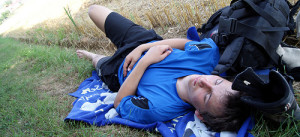by Michelle Sutton-Kerchner
Everyone needs downtime. A chance to de-stress, refresh, and enjoy a breather. Does this include time away from your fitness routine …
If you’re worried about the effects a week away can have on your exercise program, congratulate yourself. Giving consideration to a planned break from exercise is much better than taking one without realizing it. (As in, “Ooops, another week went by and I haven’t gotten to the Center.”)
Recognizing you need a break, from fitness and all else, has positive implications. You are in touch with yourself and know your limits. In an effort to avoid injury or unrecoverable burnout, you acknowledge the need for a brief hiatus. Like time away from the office or caring for a toddler, can a break have the same positive effect on our fitness routine? It all depends.
Plan of Action
Notice, “action” is still in the plan. Whether your break from a fitness routine is secondary (the result of a business trip or vacation) or primary (you feel over-trained or exhausted), make a plan. Planned breaks allow the body to rest with limitations. It does not mean you don’t leave the couch except to walk to the fridge. It does set a timeframe, perhaps the extent of which you will be out of town.
With this approach, a few days break from your routine can, well, make it seem less “routine.” Even dedicated athletes schedule breaks into their training– sometimes a week long. It might ease the guilt to realize it takes more than a week to undo fitness results, especially if you’ve been consistently committed. Studies show it takes approximately two months of inactivity to reverse the health benefits of a regular fitness program. For the seriously fit, a rapid drop in fitness occurs in the first three weeks of inactivity and then slowly diminishes.

It also helps when you have a date set to resume your formal workouts. Perhaps schedule a personal training session at the break’s end. Getting another person involved helps accountability. A trainer also can recognize any impact your break may have had (tight hamstrings, anyone?) and adjust accordingly.
Guidelines for Success
Keep up with cardio activities. Although you may not be attending your Group Fitness favorites for the week, try to include aerobic activity in your days. Aerobic fitness tends to decline more rapidly than muscular strength, at a pace of five to 10 percent during a three-week break. (Just in case you were considering an extension of that one week off.)
Muscles retain exercise memory for several weeks. Although muscles may not atrophy during your break, this fact further reinforces the need to continuously change up your fitness program. Muscle memory leads to a plateau in your workout efforts, even if it does keep you buff a little longer during an off-period.
Don’t take an extended rest until habit forms. Fitness newbies, think again. A break does not yet pertain to you. Don’t take an extended rest from routine until a routine is actually established. The first six weeks are often the most critical when forming habits. Research shows six weeks is the approximate time period necessary for a task to become automatic. A break too soon is probably not necessary, and can be detrimental.
A typical fitness schedule includes days off, not full breaks. Allow muscles to recover and the body to replenish itself for the next workout. Some chose to do a formal routine every other day. Others alternate days for cardio and strength training. This is especially beneficial when working out with weights. A day in between sessions helps avoid strains and fatigue that can lead to injury.
In the beginning, keep momentum with your fitness program. If you feel entitled to time off, grant it in the form of a new fitness class, a Pilates demo, or a new piece of exercise equipment. You aren’t ready for an official break. Plan it for tomorrow. When tomorrow arrives, plan it for next week. It is amazing what we can trick ourselves to do. Eventually, you’ll experience that “fitness high” and it will fly you forward.
Exercise vets: Can’t resist the rush of a good workout? Vary the intensity. Do Boot Camp one day, with the next followed by a leisurely swim in the pool. Take advantage of the Aquatic Center to keep intensity during heavy training while remaining low-impact. Cardio and resistance efforts are enhanced without the stress common to intense, extensive training seasons.
Maintain a Healthy Lifestyle. Your outlook can be the biggest detriment to skipping a workout, whether intentionally or because life got in the way. The all-or-nothing approach is one of the major reasons people stop exercising. Continue with other aspects of your healthy lifestyle. A break from your fitness routine is not cause for total chaos. Keep consistent with other healthy elements in your life. Or, use this time to experiment with new ones.

Meditate, go for walks, garden, stay active. Monitor your diet a little more closely. With reduced calorie-burn time must come reduced intake. There is debate over whether exercise affects appetite. For some, a good workout brings on a hearty appetite; others feel a decline in hunger. The response is based on multiple factors.
Some say a workout’s length is a factor. Study participants who worked out for 60 minutes lost the same amount of weight as 30-minute exercisers. A possible explanation: Longer workouts make exercisers feel entitled to more calories and more rest. Use this statistic to guide your eating habits during a workout break.
Focus on healthy foods that promote energy to compensate for a possible lag as your body “withdrawals” from a more vigorous exercise schedule. Proper nutrition also can be a mood-booster. Often, avid exercisers notice a slight downward mood shift or increased irritability on missed workout days. Maintaining other healthy habits helps you feel and stay your healthiest, so it will be physically and mentally easier to get back into full action after your break.

Remember Your Motive. Studies prove most people, regardless of age or gender, exercise for positive health. Interestingly, this trumped physical appearance. The true motivator to get moving is overall wellness and better health. If that results in a smaller waistline, it is doubtful many would complain.
Remind yourself of your reasons for this journey. Inspiration is personal. Use your goals to stay committed. If you need a break, take one with the idea it will propel you closer to your aspirations. Make it part of the journey, not a detour away from it.
Sources
“How Does Exercise Affect Your Appetite?” by Paige Waehner at www.about.com.
“Taking a Break from Exercise– How Long Can You Go?” by Paige Waehner at www.about.com.
“The Psychology of Exercise,” by Jim Gavin at www.ideafit.com.
Image Credits
Tropical Break (introductory photo): www.flickr.com/photos/wicker-furniture/8557428060/
Exercise Break: www.flickr.com/photos/michaelpollak/6087552051/
Hilly stairs: www.flickr.com/photos/29792566@N08/6163939170/
 Fitness & Wellness News Your Source for Fitness News, Wellness News, Health News, and Nutrition News!
Fitness & Wellness News Your Source for Fitness News, Wellness News, Health News, and Nutrition News!




